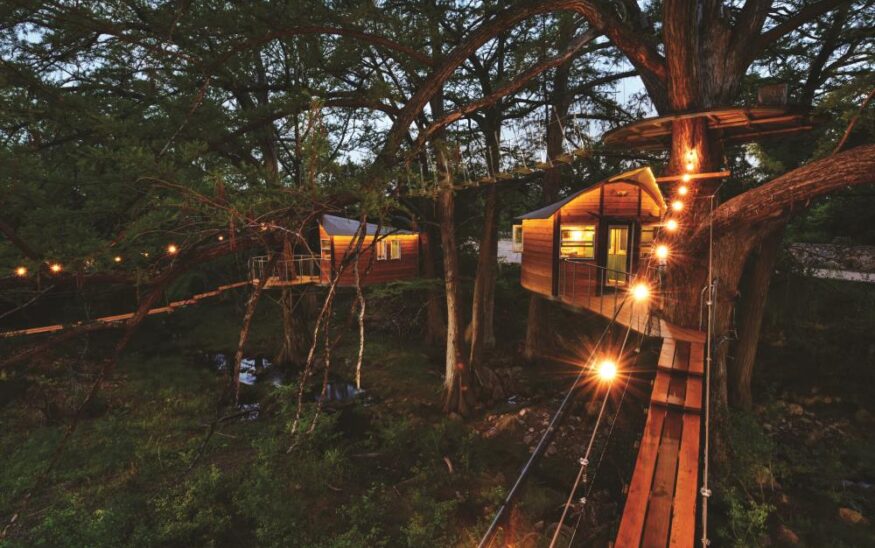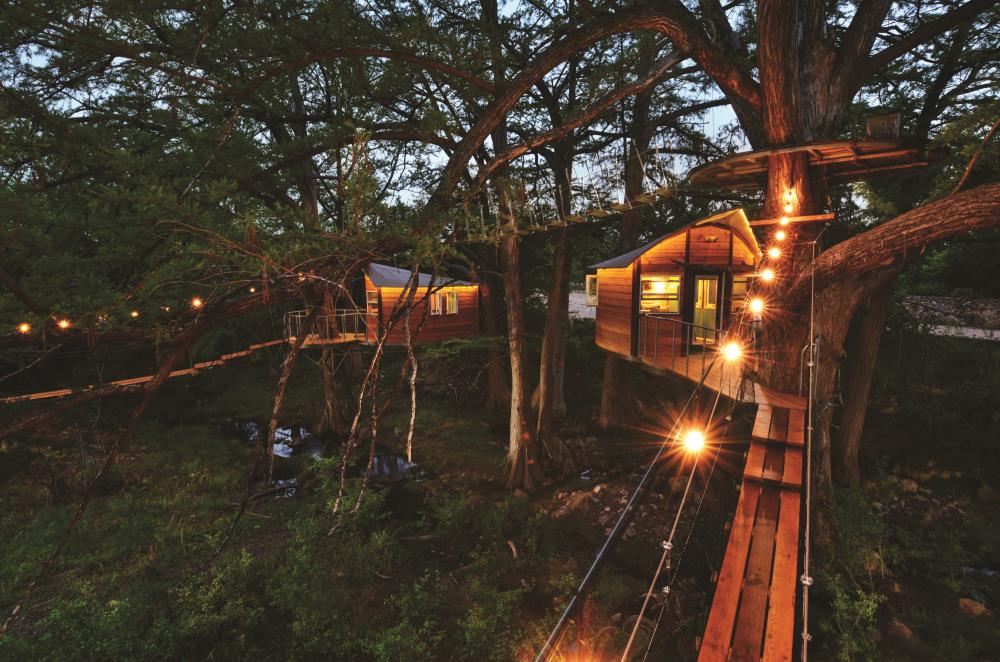Colorado Campgrounds Glitz Up the Great Outdoors
The "glamping" trend appeals to those who would rather not rough it
Jamie Siebrase //May 21, 2019//


Colorado Campgrounds Glitz Up the Great Outdoors
The "glamping" trend appeals to those who would rather not rough it
Jamie Siebrase //May 21, 2019//

Consider it a nod to our Neanderthal roots: huddling close to friends around a campfire, spinning late-night yarns under a canopy of stars. But with opposable thumbs comes a strong preference for creature comforts — and an even stronger rejection of unnecessary work.
Enter glamorous camping, or “glamping,” a best-of-both-worlds approach for “those who no longer care to set up and tear down a campsite,” says Mary Arlington, executive director of the Colorado Campground and Lodging Owners Association (CCLOA), a trade association for owners of Colorado’s private campgrounds and RV parks.
“Glamping is hot,” Arlington says. “And it’s growing by leaps and bounds compared to any other sector within camping.”
Steph Curtis-Raleigh, who publishes International Glamping Business Magazine, estimates that Europe is three years ahead of the U.S. in terms of glamping infrastructure. “But the U.S. is moving into the sector in a much more ambitious way,” Curtis-Raleigh adds.
That explains why the U.S. glamping market is projected to reach $1 billion by 2024, with a compound annual growth rate of 15-plus percent from 2018 to 2024, according to a report by Arizton Advisory & Intelligence, an Illinois-based firm providing market intelligence reports.
But because glamping is included in overall camping statistics, it’s hard to know exactly how much of the camping industry it corners. “At present, any figures on the size of the glamping sector are really just guesswork,” Curtis-Raleigh says. Camping in Colorado state parks, for example, generated more than $10 million in revenue during the 2015-16 fiscal year. But, says CPW marketing coordinator Debbie Lininger, “We don’t separate out yurt revenue specifically.” Anecdotally, though, it’s clear that glamping is “rampant” in Colorado, she says.
What’s Glamping, Anyway?
Popularized in the last decade, glamping describes a style of camping amenities allowing campers to immerse themselves in the great outdoors without actually having to rough it. While the term glamping means different things in different contexts, glampgrounds are united via unusual accommodations. The Instagram generation loves a quirky backdrop, and that’s “propelling glamping forward,” Curtis-Raleigh says.
A glampsite starts with a permanent structure that’s not a wood cabin or metal RV. Canvas is a common building material – (think: yurts, tipis) – but multi-story treehouses would probably qualify under most definitions of glamping.
Inside the structure, glampers have access to “arrangements,” Arlington says, pointing to a bed and, typically, a table with chairs. Beyond the basics, some glampsites include heating and/or cooling systems, along with amenities ranging from electricity to miniature refrigerators. “While [glampers] have the comforts of a bed and hot water,” Curtis-Raleigh says, “they still come together to carry out tasks such as making a fire, which is a great way to bring families together and get kids off their devices.”
Twenty yurts are available for rent at a handful of Colorado’s 41 state parks. “Unlike full-service glamping facilities offering plush beds, our customers bring their sleeping bags to roll out on vinyl mattresses,” Lininger says, noting that yurt amenities “vary greatly” among state parks.
At the other end of the spectrum, campers visiting luxury glampground resorts are met with five-star niceties. Arapaho Valley Ranch in Granby, for example, has a tipi village with five 20-foot tipis furnished with beds, cots and camp kitchens. At Collective Vail of Collective Retreats in Wolcott, six large-scale safari-style tents are rigged with electricity and private bathrooms, and glampers get complimentary snacks plus an optional farm-to-table dining service. Full-service glampgrounds are introducing glamping activities, too, from wine-tasting to yoga immersions, walking tours and spa treatments.
Small Segment, Big Impact
While the Colorado Tourism Office doesn’t carry glamp-specific statistics, Arlington’s organization polls its members periodically. When last surveyed in early 2019, 14 percent of some 76 private campgrounds offered glamping opportunities.
RV and tent camping, then, are still the most common forms of camping in Colorado. “Only a small percentage of campgrounds in Colorado have glampsites,” Arlington says. But for those proprietors, glamping is a powerful revenue generator.
At the Dolores River Campground in southwest Colorado, Lainey Beyhan and her husband, Billy, own and operate 78 RV sites, 10 tent sites and 10 cabins. Since buying their campground in 2013, the Beyhans have added two yurts, two covered wagons and a 1953 vintage airstream trailer to their portfolio.
Glamping makes up less than 5 percent of the Beyhan’s stock, and yet 15 percent of their total revenue comes from glampsites. It’s a phenomenon many CCLOA members have reported to Arlington, but the positive economic impact of glamping on individual campgrounds hasn’t necessarily benefited the state of Colorado — not at the same level. RV camping still brings the most camping tourism dollars to Colorado, as RV operators buy gas, propane and large stocks of groceries from area stores.
Local businesses, though, are seizing their chance to capitalize on the glamping experience, offering a slew of photogenic “DIY accessories,” including kitschy marshmallow roasting gadgets, stylish camp blankets and gourmet campfire meals.
The Glamping Demographic
In addition to connecting travelers with nature, camping is a relatively cheap way to explore the country, with average tent sites ranging from $10 to $30 a night in Colorado. “Glamping is considerably more expensive than tent camping,” says Arlington, who estimates that the average glampsite costs four times as much as the average tent site at any given Colorado campground.
“It’s not cheap, but glamping is quite the experience,” Arlington says.

And that’s the whole point for many travelers. Glamping is especially popular with millennials, who show an interest in unique experiences. But it’s not just millennials booking yurts, tipis and covered wagons.
“At the moment, I would say the majority of glampers are younger couples and families,” Curtis-Raleigh says. The latter “are looking for something fun and outdoorsy to do with the kids — something that doesn’t require the massive amount of kit and organization.”
YMCA of the Rockies-Snow Mountain Ranch added 24 yurts in 2011 in an effort to offer families an affordable lodging option.
“Prior to our yurt villages, your options at Snow Mountain Ranch were tent camping or staying in a lodge room or cabin,” says Bill Almond, marketing director for YMCA of the Rockies. Cabins could be cost-prohibitive, and Almond says that “either the lodge room was not the experience families were looking for or the campgrounds were too rustic.
“As soon as we opened our first yurt village, the yurts started selling out,” Almond says. For $99 a night, yurts come with a queen bed and two sets of bunk beds, as well as a mini-fridge, microwave and a table and chairs — and Wi-Fi. Outside, a tent pad rests a few feet from a grill and picnic table, and private bathrooms are within walking distance.
“Yurts are an easy, low-hassle way for families to have an enjoyable camping experience,” Almond says. Glamping might attract more patrons to Snow Mountain Ranch, but unlike at other campgrounds, it hasn’t been a huge revenue booster. “For us it’s a point of entry, and a way to carry out our mission,” he says.
As glamping gains traction with families, Curtis-Raleigh says it is also “re-opening the appeal of camping to an older demographic” — baby boomers, in particular, who no longer care to deal with the physical strain of sleeping on the ground. Seven million boomers are reaching retirement in the U.S. Says Curtis-Raleigh, “They have the disposable income and the sense of adventure to really embrace this form of travel.”
The Price of Glam
Dolores River Campground/Dolores
Riverfront yurts start at $77/night, $462/week, for two glampers. Additional guests are $3 nightly, and holiday rates apply. Linen
packages are offered for $20 per bed and include sheets, blanket, pillows and towels.
970-882-7761 | doloresrivercampground.com
Golden Gate Canyon State Park/Golden
Yurts at $90/night, two-night minimum, plus $8 entrance fee per vehicle.
303-582-3707 | cpw.state.co.us/placestogo/parks/GoldenGateCanyon
Never Summer Nordic/Walden
Rustic backcountry yurts for $90 to $150/night, with rates at the highest during weekends and holidays.
970-723-4070 | neversummernordic.com
YMCA of the Rockies Snow Mountain Ranch/Granby
Yurts for $99/night, sleep up to six people; lodging guests have access to free on-site activities, from hiking and canoeing to miniature golf.
970-887-2152 | snowmountainranch.org
Arapaho Valley Ranch/Granby
Furnished tipi $175/night, with access to camp kitchens, bedding, a bathhouse and a community fire pit. A two-night minimum stay is required, and discounts are available for weekday bookings.
720-550-0684 | arapahovalleyranch.com
Collective Vail of Collective Retreats/Wolcott
Luxury safari tents range from $500 to $700/night for two adults. The cost includes a full breakfast, complimentary coffee, tea, water and granola, eco-friendly bath amenities, s’mores and a personal concierge service.
970-445-2033 | collectiveretreats.com/retreat/collective-vail



























